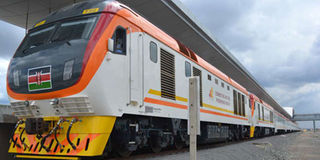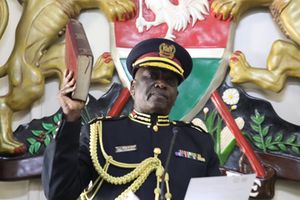SGR leads in strengthening Sino-Kenya ties

A new train at the Nairobi terminus on May 29, 2017.
What you need to know:
- The SGR is one of Kenya’s Vision 2030 flagship projects which will contribute significantly to different sectors of the economy, either directly or indirectly.
- As part of BRI, SGR is the "road of friendship" and "road of prosperity and development" for a win-win cooperation between China and Kenya in the new era.
- We are currently at nearly 80 per cent localisation and have over 290 Kenyans in management positions.
The global infrastructure landscape has changed tremendously since the advent of China’s Belt and Road Initiative (BRI), billed as the single most significant undertaking by the country on the international stage.
The initiative — a long-term policy and investment programme that aims at infrastructure development, increasing trade and acceleration of economic integration to connect Asia with Africa and Europe—was unveiled in 2013 by China’s President Xi Jinping.
BRI consists of a Silk Road Economic Belt, a trans-continental passage that links China with south east Asia, south Asia, Central Asia, Russia and Europe by land and a 21st century Maritime Silk Road, a sea route that connects China’s coastal regions with South Asia and south east, the South Pacific, the Eastern Africa and the Middle East.
The BRI’s infrastructure development goals complement the African Union’s own Agenda 2063, which mainly focuses on the continent’s interconnectivity.
They are both centred on sustainable industrialisation and industrial diversification, and generating high-value add and decent employment for all.
Carbon emission
In Africa, Kenya is a core part of both the Maritime Silk Road and the Belt, with the Standard Gauge Railway (SGR) being the flagship project of this initiative.
The project is significant in terms of saving valued natural resources and protecting the environment, especially from the challenge of global warming, because it will reduce the carbon emission footprint by introducing a modern and more efficient railway system.
It is one of Kenya’s Vision 2030 flagship projects which will contribute significantly to different sectors of the economy, either directly or indirectly.
As part of BRI, SGR is the "road of friendship" and "road of prosperity and development" for a win-win cooperation between China and Kenya in the new era. It is noteworthy that there are various similarities between Chinese and Kenyan national cultures.
For instance, they are both collectivist societies where people value each other and form strong interpersonal relationships with their families, friends and communities.
People from collectivist societies are good team players, which is very important for SGR operations and maintenance. The scalability of SGR operations and maintenance is dependent on the localisation of the project
We are currently at nearly 80 per cent localisation and have over 290 Kenyans in management positions.
Technical skills
The localisation rate has been achieved through technical skills training, which includes RTI pre-job training, on-the-job vocational training, apprenticeship programs, and professional development opportunities.
In my opinion, the SGR has shortened the space-time distance between Nairobi and Mombasa, changed the way people travel, and increased business activities along the line.
It has played a positive role in promoting the economic and social development of Kenya and even East Africa. As at August 27, 2020, the SGR has transported over 4.37 million passengers and 948,700 TEUs since its launch.




